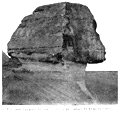Sphinx
(
Σφίγξ, “the throttler”). A monster
borrowed from Egyptian religion and symbolism, orig
 |
|
Winged Sphinx of Greek Art. (From a fragment of pottery found at Daphnae. Drawing by
Petrie.)
|
inally represented with the body of a winged lion and the breast and head of a human
being, and subsequently in still more wonderful forms, as a man or woman with the breast,
feet, and claws of a lion, the tail of a serpent, and the wings of a bird; or as a lion in
front and a human being behind, with vulture's claws and eagle's wings. The Egyptian sphinxes
are oftener male rather than female, and the Great Sphinx was intended to represent the god
Hor-em-khu or Horus.
 |
|
The Great Egyptian Sphinx. (From a photograph by Flinders Petrie.)
|
It is older than the Fourth Dynasty, which began about B.C. 3700.
According to Hesiod, Sphinx was the daughter of the Chimaera and Orthrus; according to
others, of Echidna and Typhon. Heré (or, according to others, Ares or Dionysus), in
anger at the crimes of Laïus, sent her to Thebes from Ethiopia. She took up her abode
on a rock near the city and gave every passer-by the well-known riddle, “What walks
on four legs in the morning, on two at noon, and on three in the evening?” She flung
from the rock all who could not answer it. When Oedipus explained the riddle rightly, as
referring to man in the successive stages of infancy, the prime of life, and old age, she
flung herself down from the rock. See
Oedipus.






